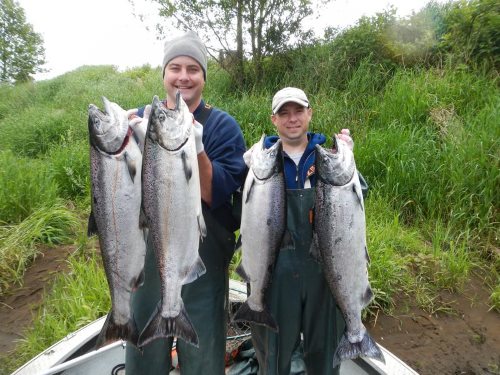2024 Editor’s Note: The Trask River’s fall Chinook fishery has seen some poorer years recently than when this article was written. The 2022 season (the most recent catch statistics available at the time of this update) showed only about 200 fall Chinook harvested. That’s a tenth the size of runs we’d like to see.
The 2022 spring Chinook run fared a bit better, with more than 1,200 springers harvested in the Trask that year.
The Trask River near Tillamook is home to some of the north coast’s largest fall Chinook salmon, and its spring run typically is significantly better than springer returns to nearby rivers like the Wilson and often better than the Nestucca.
The Trask is about an hour and a half from the Portland area and also has other fishing opportunities (see this article for an overview).
Fall Chinook
The neighboring Wilson River sometimes produces more fall Chinook during a season, but the Trask has some of the longest fall fish you’ll find in the Tillamook Bay system and, in fact, on this entire section of coastline.
The Trask’s fall Chinook harvests vary wildly. Some years the catches are below 1,000 fish. Other years anglers take home several thousand of the big salmon.
Fishing can often get good in the tidewater sections in Tillamook in late September and through October, with the overall catch from the bay through tidewater and into the river usually peaking in October. There often is good late-season fishing for Chinook into November and even December, said ODFW fish biologist Robert Bradley.
In the tidewater area, fishing can be very good. Look for public access at the Hospital Hole in town, under the Highway 101 Bridge and just above that at the takeout at Steiners, reached from Long Prairie Road about a quarter mile above the highway.
Above tidewater, Bradley advises most anglers to fish from the Cedar Creek boat launch downriver, where the fall Chinook are usually brighter than farther upstream. The launch is upstream from the hatchery, near Milepost 5 on Trask River Road.
Farther downriver, Loren’s Drift is a very popular area, reached from Chance Road on the south side of the river. The Turner Hole is one place to try there.
In the upper river, above Cedar Creek, anglers will find better bank access but will need to pick through some dark fish to harvest the brighter ones. Options up there include the hole below the forks at Trask River Park, the Girl Scout Bridge and Stone Camp Slide.
The Hatchery Hole and Dam Hole (near Milepost 7) both are closed until December, although there are a few fish around then.
The Trask also has a fall run of fin-clipped coho salmon returning to the hatchery. The catch tends to be modest in number but can cause a quick flurry or two of fishing action after the first significant early fall rains.
Spring Chinook
Now and then, the spring catches here can be as high as the harvests during this river’s excellent fall season, which is unusual for coastal Chinook fisheries. Other years the catch rates are more modest.
Good catches many seasons could continue now that ODFW has moved its former Wilson River spring Chinook smolt releases to increase the releases into the Trask, which could add more fish to this system.
The spring run first appears in April but really gets going in May and June before tapering off through July.
Most of the spring Chinook catch comes from the hatchery downstream, at such spots as the Maple Tree Hole as well as Turner Hole at Loren’s Drift. By June, as long as there’s enough water, drift boats will pretty much have to float from Loren’s Drift down to Steiners (just above Highway 101).
Springers here do stray upriver past the hatchery and can be caught above Cedar Creek, including bank access spots at Stone’s Road and the Girl Scout Bridge. The fish up here aren’t always as chrome bright as lower-river fish, especially as the season’s end approaches (open through July 31).
Best River Levels
The Trask River has a river level gauge, but experienced anglers around here often key in on the gauge at the nearby Wilson River. Conventional fishing wisdom is that if the Wilson gauge is reading about 4 to 5.5 feet, fishing conditions on both similar-sized rivers should be quite good.
The actual reading at the Trask gauge generally runs a couple feet higher than the Wilson number.
Note special regulations for the Hatchery Hole and Dam Hole sections of this river. In-season changes are possible.
Current Wilson River Level and Forecast
Return to Oregon Salmon Fishing page
Oregon Resources
ODFW Weekly Fishing Report
ODFW Trout Stocking Schedule
Oregon Fishing Regulations
National Weather Service

